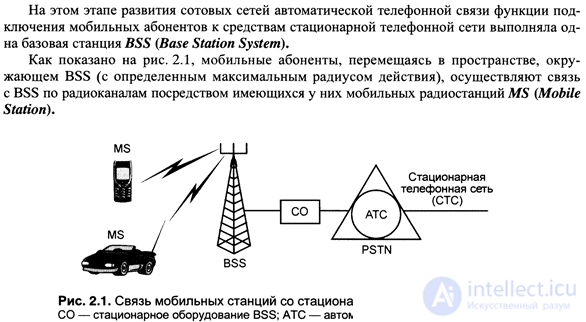Lecture
The first land mobile communication systems with automatic switching and routing connections were developed and implemented in the 60s of the XX century.
At this stage of development of cellular networks of automatic telephone communication, the function of connecting mobile subscribers to the fixed telephone network means was performed by one base station BSS (Base Station System).
As shown in fig. 2.1, mobile subscribers, moving in the space surrounding the BSS (with a certain maximum range), communicate with the BSS via radio channels using their mobile radio stations MS (Mobile Station).

Further, BSS connected mobile subscribers to the fixed telephone network.
This simplest mobile network, which essentially implies one cell (cell) for MS-BSS interaction, had the following significant drawbacks:
- Dependence of communication quality on the distance between MS and BSS (to maintain high quality of radio communication, it was necessary to use radio stations with adjustable transmitter output power over a wide range of levels depending on the distance between MS and BSS, which was quite difficult to implement at that time);
- limited number of connected mobile stations MS due to the limited number of radio channels (limited number of allocated operating frequencies / wavelengths).
In the development of cellular mobile communication networks, these shortcomings were eliminated by replacing one powerful BSS with several BTS (Base Transceiver Station), which have lower transmitter powers and their individual service areas (Fig. 2.2). At the same time, cellular mobile communication networks are constructed as a set of cells (cells — cells, cells) schematically depicted in the form of equal regular hexagons, which resembles bee cells, and therefore the mobile communication network was called cellular or cellular. At the center of each i-th cell is the BTS, serving all MSs within its cell.
When implementing such a network, a technical problem immediately arises - how to switch a moving subscriber MS from one cell to another. To solve this problem, a mobile switching network MSC (MobileServicesSwitchingCenter) is provided in the cellular mobile communication network. It provides switching of the established conversational path when a mobile subscriber moves from one cell to another, as well as connecting fixed telephone subscribers to a specific BTS with this mobile subscriber.
When creating the network shown in Fig. 2.2, it became necessary to control the movement (roaming) of the mobile station MS, which is both in a free (from the point of view of communication) state and in a state of employment. It should be noted that
When using the network, the fixed telephone network is exempt from servicing calls from one mobile subscriber to another. Such connections are established through the MSC switching center.
2.2. Cellular mobile network In a modern cellular mobile network, there are usually several MSC switching centers, each of which |
Consider the features of dividing the territory serviced by mobile communication into cells. There are two main ways to divide the service area into cells:
- the first one is based on measuring the statistical characteristics of the propagation of radio signals in a given communication system;
- the second one is based on measuring or calculating the parameters of radio signal propagation for a specific area.
When implementing the first method, the entire serviced territory is divided into cells (cells) of the same shape and using the methods of statistical radio engineering, their allowable sizes and distances to other cells within which the conditions of allowable mutual influence are met are determined.
To obtain the optimal (that is, without overlapping or missing sections) of the division of territory into cells, only three geometric shapes can be used - a triangle, a square and a regular hexagon. The most suitable figure is a hexagon, since if the antenna with a circular pattern of BTS is installed in its center, access will be provided to almost all parts of the cell.
In reality, honeycombs are never a strict geometric form.
In reality, cell boundaries have the form of irregular curves depending on the conditions of propagation and attenuation of radio waves, that is, on the topography of the terrain, the nature and density of vegetation, building development and many other factors.
Moreover, the cell boundaries are not clearly defined at all, since at the turn of the handover of a mobile station from one cell to the next one, these boundaries may shift within certain limits with changes in radio propagation conditions and depending on the direction of motion of the mobile station. Similarly, the position of the base transceiver station BTS only approximately coincides with the center of the cell, which is also not so easy to determine unambiguously if the cell has an irregular shape. If, however, directional antennas are used at BTS, then BTS in real cases may actually end up on cell boundaries.
When using the first method of dividing a territory into cells, the interval between cells, in which the same working channels are used, usually results in more than the required interval - in order to maintain mutual interference at an acceptable level.
A more acceptable second method is the division of territory into cells. In this case, the cellular system parameters are measured or calculated for a certain minimum number of basic BTS receiving and transmitting stations providing satisfactory customer service throughout the territory, determining the optimal location of the BTS taking into account the terrain relief and other factors affecting the propagation conditions of radio waves, consider using directional antennas, passive repeaters and adjacent BTS at the time of peak load, etc.
Comments
To leave a comment
GSM Basics
Terms: GSM Basics